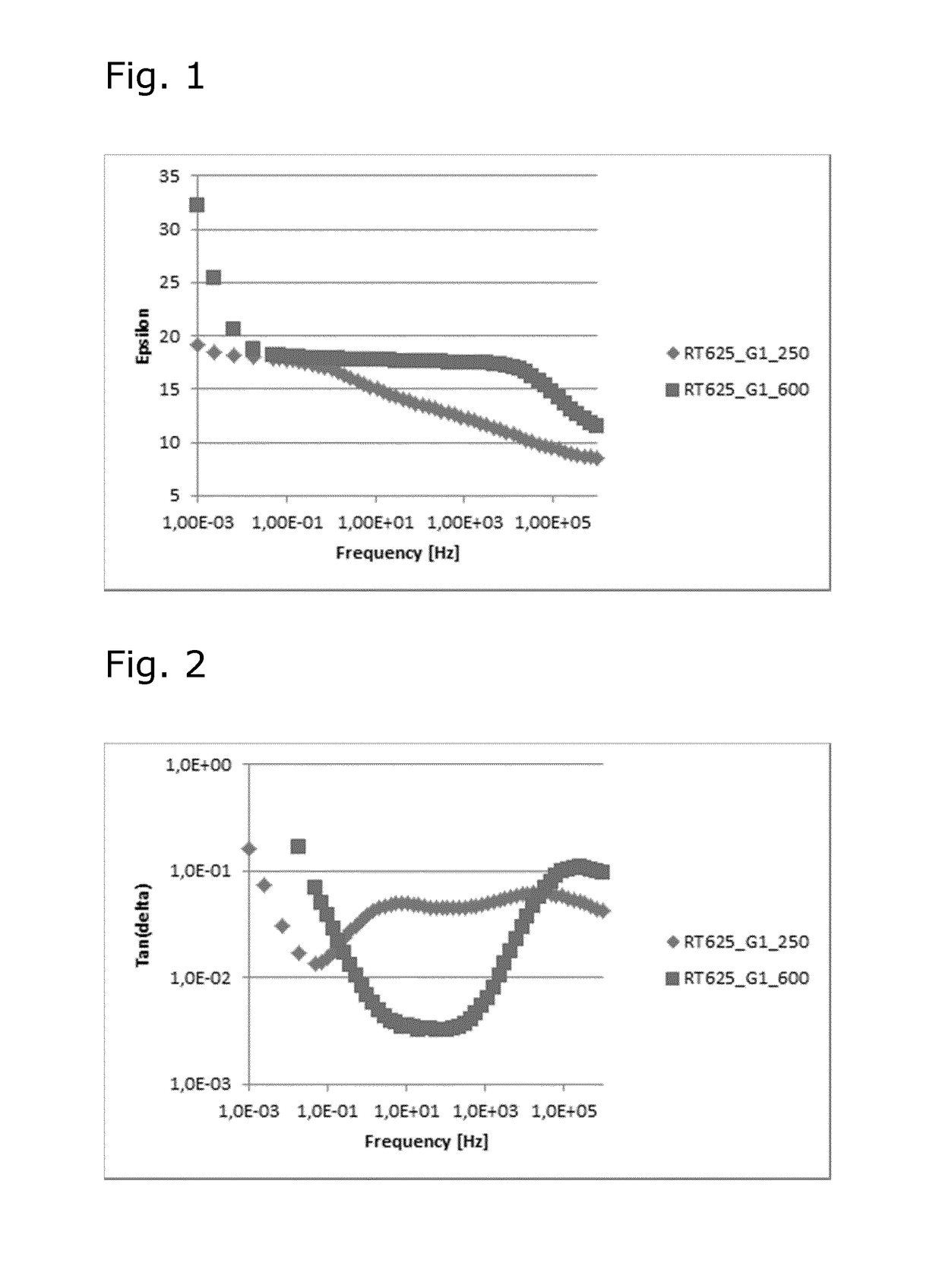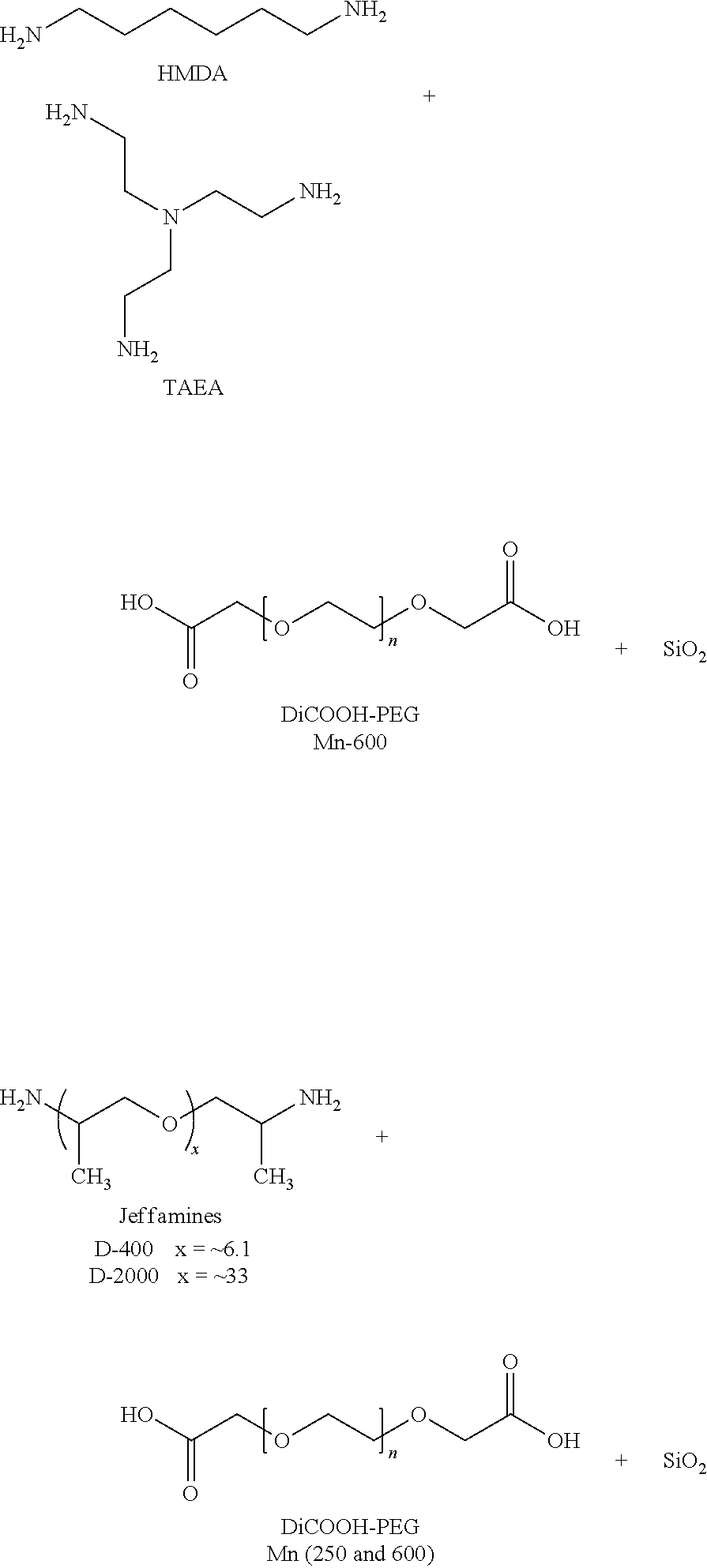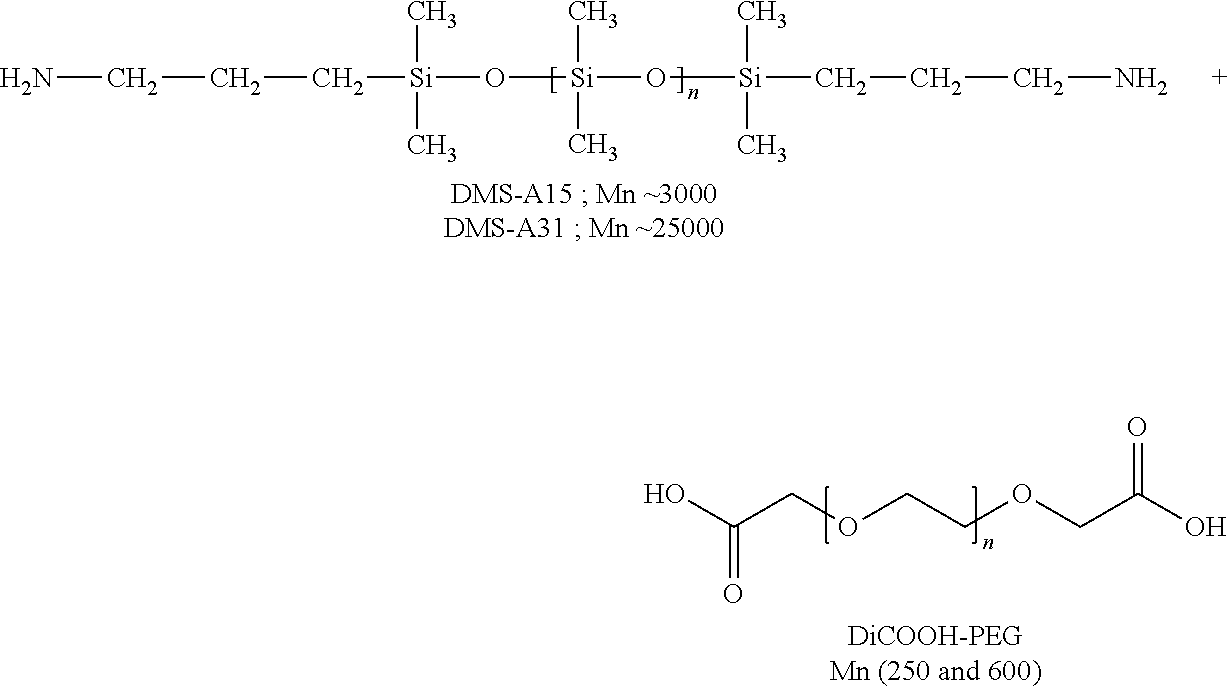Dielectric electroactive polymers comprising an ionic supramolecular structure
a polymer and supramolecular structure technology, applied in the direction of rubber insulators, plastic/resin/waxes insulators, organic insulators, etc., can solve the problems of high operation voltage, reducing the thickness to less than 5 m, and high electrical energy density with lowered operating voltages, so as to improve the relative dielectric permittivity
- Summary
- Abstract
- Description
- Claims
- Application Information
AI Technical Summary
Benefits of technology
Problems solved by technology
Method used
Image
Examples
example 1
[0062]General Description of the Preparation of Ionic Supramolecular Polymers
[0063]A number of different ionic supramolecular polymers having the compositions as listed in Table 1 below were prepared as follows. Silica (SiO2) was used as model for a silicone elastomer.
[0064]The ionic supramolecular structures (entries 1-7, 9 and 19-22 below) were prepared by simple mixing of stoichiometric amounts of HMDA or TAEA or poly(propylene imine) dendrimers (PPI G1 and PPI G2) and the different dicarboxylic acids (DiCOOH-PEG 250 and 600, respectively) without the use of solvent followed by manual stirring. A network formation was directly observable as the formation of these ionic systems was exothermic. Furthermore, a viscosity increase of the mixtures could be observed. In the case of the ionic supramolecular structure (entry 11) heating was needed since DiCOOH-PEG 4756 is a solid. The ionic supramolecular structures (entries 12-18) were prepared by simply mixing followed by magnetically s...
example 2
[0067]Preparation of Ionic Interpenetrating Polymer Networks (IPNs)
[0068]Ionic interpenetrating polymer networks (IPNs) were prepared by mixing of equal amounts by weight of the elastomer Elastosil® RT625 A / B from Wacker Chemie AG and different supramolecular structures. Elastosil® RT625 A / B is a two parts kit to be used in a 9:1 ratio of Part A to Part B as the manufacturer recommends. The supramolecular structures were formed by simple mixing of stoichiometric amounts of poly(propylene imine) dendrimer (PPI G1) and two dicarboxylic acids (DiCOOH-PEG 250 and 600, respectively) without any use of solvent.
[0069]2.1 Preparation of Elastomer
[0070]Elastosil® RT625 A / B was used in the ratio 9:1 by mixing 9.0196 g of A and 1.0064 g of B. The mixture was prepared using a Speed Mixer instrument set at 3500 rpm for 60 s.
[0071]2.2 Preparation of Ionic Interpenetrating Polymer Networks
[0072]The ionic interprenetrating polymer networks (IPNs) were prepared by mixing of equal amounts by weight o...
example 3
[0079]The following ionic supramolecular structures were prepared analogously to the procedure described in Example 1. Heating was not applied in this example.
[0080]
[0081]The relative permittivities of the above supramolecular structures were determined as described in Example 2.
[0082]
TABLE 3Relative permittivities (∈′) of ionic supramolecular structures.Relative permittivities (∈′)0.11.021.08 · 1011.13 · 1021.20 · 1031.26 · 1041.33 · 105106EntryCompositionHzHzHzHzHzHzHzHz1HMDA + DiCOOH-PEG 600 (1:1) + 10% SiO22.08 · 1067.49 · 1052.43 · 1053.38 · 1041.52 · 10354.723.612.202TAEA + DiCOOH-PEG 600 (1:1.5) + 10% SiO27.21 · 1057.16 · 1044.63 · 10381.3817.1610.827.065.093D400 + DiCOOH-PEG 250 (1:1) + 10% SiO24.82 · 1051.13 · 1057.61 · 1031.20 · 10217.2412.126.063.944D2000 + DiCOOH-PEG 250 (1:1) + 10% SiO22.06 · 1055.05 · 1042.47 · 10359.3812.2510.578.846.865D400 + DiCOOH-PEG 600 (1:1) + 10% SiO21.77 · 1067.29 · 1051.17 · 1057.90 · 1031.34 · 10225.1055.6712.636D2000 + DiCOOH-PEG 600 (1:1) ...
PUM
| Property | Measurement | Unit |
|---|---|---|
| thickness | aaaaa | aaaaa |
| relative dielectric permittivity | aaaaa | aaaaa |
| molecular weight | aaaaa | aaaaa |
Abstract
Description
Claims
Application Information
 Login to View More
Login to View More - R&D
- Intellectual Property
- Life Sciences
- Materials
- Tech Scout
- Unparalleled Data Quality
- Higher Quality Content
- 60% Fewer Hallucinations
Browse by: Latest US Patents, China's latest patents, Technical Efficacy Thesaurus, Application Domain, Technology Topic, Popular Technical Reports.
© 2025 PatSnap. All rights reserved.Legal|Privacy policy|Modern Slavery Act Transparency Statement|Sitemap|About US| Contact US: help@patsnap.com



